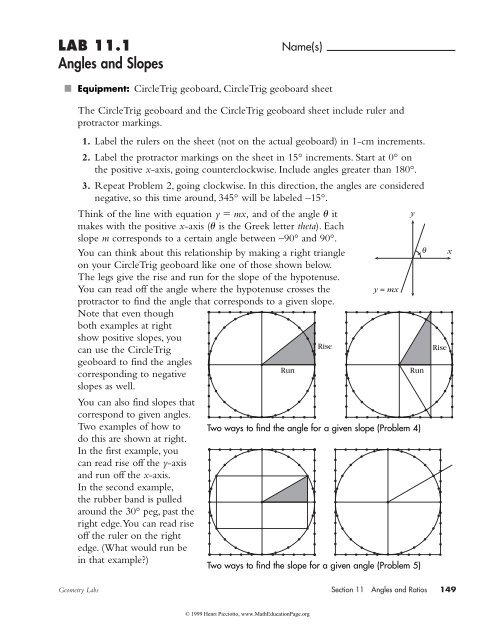Create successful ePaper yourself
Turn your PDF publications into a flip-book with our unique Google optimized e-Paper software.
LAB 11.1<br />
Angles and Slopes<br />
Name(s)<br />
Equipment: CircleTrig geoboard, CircleTrig geoboard sheet<br />
The CircleTrig geoboard and the CircleTrig geoboard sheet include ruler and<br />
protractor markings.<br />
1. Label the rulers on the sheet (not on the actual geoboard) in 1-cm increments.<br />
2. Label the protractor markings on the sheet in 15° increments. Start at 0° on<br />
the positive x-axis, going counterclockwise. Include angles greater than 180°.<br />
3. Repeat Problem 2, going clockwise. In this direction, the angles are considered<br />
negative, so this time around, 345° will be labeled –15°.<br />
Think of the line with equation y mx, and of the angle it<br />
y<br />
makes with the positive x-axis ( is the Greek letter theta). Each<br />
slope m corresponds to a certain angle between –90° and 90°.<br />
You can think about this relationship by making a right triangle<br />
on your CircleTrig geoboard like one of those shown below.<br />
The legs give the rise and run for the slope of the hypotenuse.<br />
You can read off the angle where the hypotenuse crosses the<br />
y = mx<br />
protractor to find the angle that corresponds to a given slope.<br />
Note that even though<br />
both examples at right<br />
show positive slopes, you<br />
can use the CircleTrig<br />
Rise<br />
geoboard to find the angles<br />
Run<br />
corresponding to negative<br />
slopes as well.<br />
You can also find slopes that<br />
correspond to given angles.<br />
Two examples of how to Two ways to find the angle for a given slope (Problem 4)<br />
do this are shown at right.<br />
In the first example, you<br />
can read rise off the y-axis<br />
and run off the x-axis.<br />
In the second example,<br />
the rubber band is pulled<br />
around the 30° peg, past the<br />
right edge.You can read rise<br />
off the ruler on the right<br />
edge. (What would run be<br />
in that example)<br />
Two ways to find the slope for a given angle (Problem 5)<br />
Run<br />
Rise<br />
x<br />
Geometry Labs Section 11 Angles and Ratios 149<br />
© 1999 Henri Picciotto, www.MathEducationPage.org






